
Hovea linearis is a species of flowering plant in the family Fabaceae and is endemic to eastern Australia. It is an erect or trailing subshrub with mostly narrowly linear to linear leaves with stipules at the base, and mauve and yellowish-green, pea-like flowers.

Pultenaea scabra, commonly known as rough bush-pea, is a species of flowering plant in the family Fabaceae and is endemic to south-eastern continental Australia. It is an erect or spreading shrub with hairy stems, heart-shaped leaves with the narrower end towards the base, and yellow and red, pea-like flowers.

Kennedia prostrata, commonly known as running postman, scarlet coral pea or scarlet runner, is a species of flowering plant in the family Fabaceae and is endemic to Australia. It is a prostrate or twining shrub with trifoliate leaves and, usually, red flowers.

Melaleuca fulgens, commonly known as the scarlet honey myrtle, is a plant in the myrtle family Myrtaceae, and is endemic to Western Australia, South Australia and the Northern Territory. It is notable for its showy orange, red or purple flowers, unusual foliage and fruit, and is a popular garden plant. It is a member of Melaleuca, a large and diverse genus whose members range from large trees such as M. quinquenervia, to small shrubs.

Bossiaea foliosa, commonly known as leafy bossiaea, is a species of flowering plant in the family Fabaceae and is endemic to south-eastern Australia. It is an erect shrub with small, broadly egg-shaped to round leaves, and bright yellow flowers.
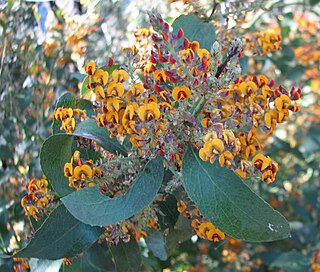
Daviesia latifolia, commonly known as hop bitter-pea, is a species of flowering plant in the family Fabaceae and is endemic to south-eastern Australia. It is a slender, erect, spreading shrub with elliptic, egg-shaped or lance-shaped phyllodes and orange-yellow and maroon flowers in long racemes.
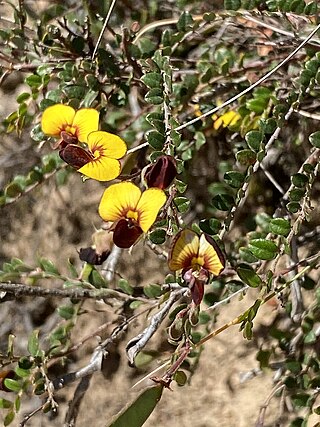
Bossiaea prostrata, commonly known as creeping bossiaea, is a prostrate understory shrub in the pea family, Fabaceae. It is a widespread species with orange-yellow flowers, purple-brown keels and trailing branches.

Melaleuca calycina is a shrub in the myrtle family, Myrtaceae, and is endemic to the south-west of Western Australia. It is a stiff, erect shrub with oval to heart-shaped leaves, white flowers and star-shaped fruit.
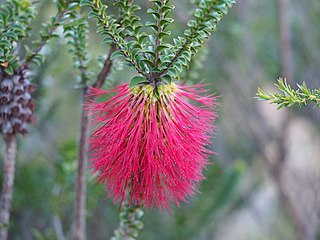
Beaufortia decussata, commonly known as gravel bottlebrush, is a species of flowering plant in the myrtle family, Myrtaceae and is endemic to the southwest of Western Australia. It has long stems branching only near the upper ends, and scarlet to orange-red flowers in a bottlebrush shape beneath the branches.

Bossiaea obcordata, commonly known as spiny bossiaea, is a species of flowering plant in the family Fabaceae and is endemic to south-eastern continental Australia. It is an erect, rigid shrub with spiny branches, heart-shaped to egg-shaped with the narrower end towards the base, and yellow and purplish-brown flowers.

Bossiaea linophylla is a species of flowering plant in the family Fabaceae and is endemic to the south-west of Western Australia. It is a spreading shrub with linear to oblong or egg-shaped leaves, and bright yellow to orange or apricot-coloured and red flowers.

Bossiaea sericea is a species of flowering plant in the family Fabaceae and is endemic to higher areas of south-eastern continental Australia. It is an erect shrub with more or less round to heart-shaped leaves with the narrower end towards the base, and yellow flowers.

Daviesia mimosoides, commonly known as blunt-leaf bitter-pea, narrow-leaf bitter pea or leafy bitter-pea, is a species of flowering plant in the family Fabaceae and is endemic to eastern continental Australia. It is an open shrub with tapering, linear, elliptic or egg-shaped phyllodes, and groups of orange-yellow and dark brownish-red to maroon flowers.
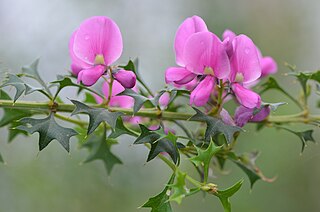
Mirbelia dilatata, commonly known as holly-leaved mirbelia, is a species of flowering plant in the family Fabaceae and is endemic to the south-west of Western Australia. It is an erect, bushy, shrub with prickly leaves and pink, purple or violet flowers.
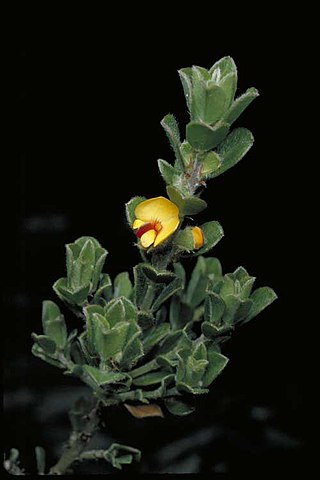
Pultenaea heterochila is a species of flowering plant in the family Fabaceae and is endemic to the south of Western Australia. It is an erect, low-lying or prostrate shrub with hairy leaves and yellow and red flowers.

Bossiaea dentata is a species of flowering plant in the family Fabaceae and is endemic to the south of Western Australia. It is an erect, sometimes prostrate shrub with variably-shaped leaves and greenish-yellow or pink to burgundy-coloured flowers.

Bossiaea disticha is a species of flowering plant in the family Fabaceae and is endemic to the far southwest of Western Australia. It is a weak, slender shrub with oblong to egg-shaped leaves and bright yellow and red flowers.
Bossiaea distichoclada is a species of flowering plant in the family Fabaceae and is endemic to south-eastern continental Australia. It is an erect shrub with hairy branches, kidney-shaped to more or less round or heart-shaped leaves with the narrower end towards the base, and uniformly bright yellow flowers.

Bossiaea ornata, commonly known as broad leaved brown pea, is a species of flowering plant in the family Fabaceae and is endemic to the south-west of Western Australia. It is a shrub with variably-shaped leaves, typically egg-shaped or oblong, and yellow or orange-yellow and reddish-brown flowers.

Bossiaea rufa is a species of flowering plant in the family Fabaceae and is endemic to the south-west of Western Australia. It is a loose, many-branched shrub with elliptic to egg-shaped leaves with the narrower end towards the base, and deep yellow and red flowers.

























